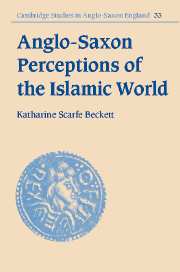Book contents
- Frontmatter
- Contents
- Acknowledgements
- List of abbreviations
- 1 Introduction
- 2 Islam during the Anglo-Saxon period
- 3 Anglo-Saxon contacts with Islam
- 4 Arabs and Arabia in Latin
- 5 Ismaelites and Saracens in Latin
- 6 Arabs, Ismaelites and Saracens in early Anglo-Latin
- 7 Pseudo-Methodius and the sons of Ismael
- 8 Arabs, Ismaelites and Saracens in Old English
- 9 Persisting theories about Saracens in post-Conquest England
- 10 Conclusions
- Bibliography
- Index
5 - Ismaelites and Saracens in Latin
Published online by Cambridge University Press: 22 September 2009
- Frontmatter
- Contents
- Acknowledgements
- List of abbreviations
- 1 Introduction
- 2 Islam during the Anglo-Saxon period
- 3 Anglo-Saxon contacts with Islam
- 4 Arabs and Arabia in Latin
- 5 Ismaelites and Saracens in Latin
- 6 Arabs, Ismaelites and Saracens in early Anglo-Latin
- 7 Pseudo-Methodius and the sons of Ismael
- 8 Arabs, Ismaelites and Saracens in Old English
- 9 Persisting theories about Saracens in post-Conquest England
- 10 Conclusions
- Bibliography
- Index
Summary
The Arabs and Saracens shared a homeland, but occupied separate spaces in western Christian thought. By far the larger space was devoted to the Saracens and their relationships with Ismaelites, Israelites and other Old Testament tribes. Jerome comments on the kings of Arabia and the tribes of Tema, Dedan and Buz: ‘Hae gentes in solitudine sunt, uicinae et mixtae regionibus Ismahelitarum, quos nunc Saracenos uocant et de quibus dicitur: qui attonsi sunt in comam’. While he groups the kings of Arabia together with the Saracens, Jerome does not indicate their relationship beyond the fact that they inhabit the same region. However, he does make it plain that the Ismaelites lived in Arabia and were, by his lifetime, known as Saracens. His comment elsewhere on ‘Arabas et Agarenos, quos nunc Sarracenos uocant’ likewise does not state categorically that the Arabs and Hagarenes are identical. Other references in Jerome's works suggest that the reader is to understand ‘Arabs, and also Hagarenes, the latter now called Saracens’. It seems that Jerome thought of ‘Ismaelite’, ‘Hagarene’ and ‘Saracen’ as different names for the same people (who were not necessarily also Arabs). This is confirmed by a line in his continuation of the chronicle by Eusebius: ‘Abraham ex ancilla Agar generat Ismael, a quo Ismaelitarum genus, qui postea Agareni, et ad postremum Saraceni dicti’.
- Type
- Chapter
- Information
- Anglo-Saxon Perceptions of the Islamic World , pp. 90 - 115Publisher: Cambridge University PressPrint publication year: 2003

